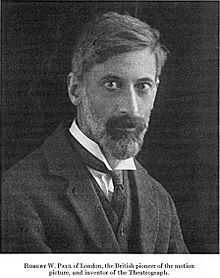Film innovation
Paul obtained a concession to operate a kinetoscope parlour at the Earls Court Exhibition Centre, and the success of this venture inspired him to attempt surpassing Edison by projecting moving images onto a screen. While Paul and Birt Acres shared innovator status for creating Britain's first 35mm camera, they quickly dissolved the partnership to operate as competitors in the film camera and projector markets.
Acres would present his projector at the Royal Photographic Society on 14 January 1896 to much acclaim. Paul would present his own, the Theatrograph, shortly after on 20 February at Finsbury Park College, ironically on the same day as the Lumière brothers first film projections in London.
In 1896, he pioneered a system of projecting motion pictures onto a screen using a double Maltese cross system, coinciding with the Lumière brothers' projection system. After some demonstrations before scientific groups, he was asked to supply a projector and staff to the Alhambra Music Hall in Leicester Square, and he presented his first theatrical programme on 25 March 1896. This included films shot by Birt Acres, featuring cartoonist Tom Merry drawing caricatures of the German Emperor Kaiser Wilhelm II (1895) and Prince Bismarck (1895). Merry had previously performed his lightning-fast drawing as part of a music hall stage act. Nearby, the Lumière brothers showcased their projections at Empire Music Hall. The use of his Theatrograph in music halls across England helped popularize cinema among the British population. To support the many showmen interested in making films of local interest, Paul established a separate manufacturing department focused on cameras, projectors, and cinema equipment with a dedicated office and showroom.
Continuing his innovations with portable cameras, Paul built the 'Cinematograph Camera No. 1' in April 1896, the first camera to feature reverse-cranking. This mechanism allowed for the same film footage to be exposed several times. The ability to create super-positions and multiple exposures was used in Paul's 1901 film Scrooge, or, Marley's Ghost, the oldest known film adaptation of Charles Dickens' A Christmas Carol. French filmmaker Georges Méliès began his career using cameras built by Paul.
In 1898, he designed and constructed Britain's first film studio in Muswell Hill, North London.
The British Film Catalogue credits Paul's Our New General Servant (1898) with the "first use of intertitles".
